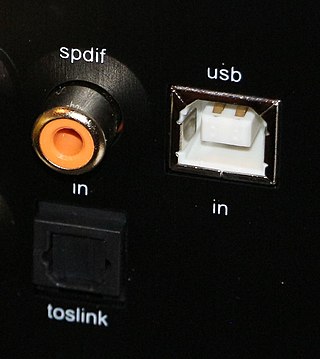Related Research Articles
A frame is a digital data transmission unit in computer networking and telecommunication. In packet switched systems, a frame is a simple container for a single network packet. In other telecommunications systems, a frame is a repeating structure supporting time-division multiplexing.

Time-division multiplexing (TDM) is a method of transmitting and receiving independent signals over a common signal path by means of synchronized switches at each end of the transmission line so that each signal appears on the line only a fraction of time according to agreed rules, e.g. with each transmitter working in turn. It can be used when the bit rate of the transmission medium exceeds that of the signal to be transmitted. This form of signal multiplexing was developed in telecommunications for telegraphy systems in the late 19th century but found its most common application in digital telephony in the second half of the 20th century.

Digital Visual Interface (DVI) is a video display interface developed by the Digital Display Working Group (DDWG). The digital interface is used to connect a video source, such as a video display controller, to a display device, such as a computer monitor. It was developed with the intention of creating an industry standard for the transfer of uncompressed digital video content.

S/PDIF is a type of digital audio interface used in consumer audio equipment to output audio over relatively short distances. The signal is transmitted over either a coaxial cable using RCA or BNC connectors, or a fibre-optic cable using TOSLINK connectors. S/PDIF interconnects components in home theaters and other digital high-fidelity systems.
AES3 is a standard for the exchange of digital audio signals between professional audio devices. An AES3 signal can carry two channels of pulse-code-modulated digital audio over several transmission media including balanced lines, unbalanced lines, and optical fiber.
GeoPort is a serial data system used on some models of the Apple Macintosh that could be externally clocked to run at a 2 megabit per second data rate. GeoPort slightly modified the existing Mac serial port pins to allow the computer's internal DSP hardware or software to send data that, when passed to a digital-to-analog converter, emulated various devices such as modems and fax machines. GeoPort could be found on late-model 68K-based machines as well as many pre-USB Power Macintosh models and PiPPiN. Some later Macintosh models also included an internal GeoPort via an internal connector on the Communications Slot. Apple GeoPort technology is now obsolete, and modem support is typically offered through USB.
AC'97 is an audio codec standard developed by Intel Architecture Labs and various codec manufacturers in 1997. The standard was used in motherboards, modems, and sound cards.

Serial digital interface (SDI) is a family of digital video interfaces first standardized by SMPTE in 1989. For example, ITU-R BT.656 and SMPTE 259M define digital video interfaces used for broadcast-grade video. A related standard, known as high-definition serial digital interface (HD-SDI), is standardized in SMPTE 292M; this provides a nominal data rate of 1.485 Gbit/s.

Transition-minimized differential signaling (TMDS) is a technology for transmitting high-speed serial data used by the DVI and HDMI video interfaces, as well as by other digital communication interfaces.
Inter-Integrated Circuit Sound is a serial interface protocol for transmitting two-channel, digital audio as pulse-code modulation (PCM) between integrated circuit (IC) components of an electronic device. An I²S bus separates clock and serial data signals, resulting in simpler receivers than those required for asynchronous communications systems that need to recover the clock from the data stream. Alternatively, I²S is spelled I2S or IIS. Despite a similar name, I²S is unrelated to I²C.
In telecommunication, 4B5B is a form of data communications line code. 4B5B maps groups of 4 bits of data onto groups of 5 bits for transmission. These 5-bit words are predetermined in a dictionary and they are chosen to ensure that there will be sufficient transitions in the line state to produce a self-clocking signal. A collateral effect of the code is that 25% more bits are needed to send the same information.
Dolby Digital Plus, also known as Enhanced AC-3, is a digital audio compression scheme developed by Dolby Labs for the transport and storage of multi-channel digital audio. It is a successor to Dolby Digital (AC-3), and has a number of improvements over that codec, including support for a wider range of data rates, an increased channel count, and multi-program support, as well as additional tools (algorithms) for representing compressed data and counteracting artifacts. Whereas Dolby Digital (AC-3) supports up to five full-bandwidth audio channels at a maximum bitrate of 640 kbit/s, E-AC-3 supports up to 15 full-bandwidth audio channels at a maximum bitrate of 6.144 Mbit/s.
A Serializer/Deserializer (SerDes) is a pair of functional blocks commonly used in high speed communications to compensate for limited input/output. These blocks convert data between serial data and parallel interfaces in each direction. The term "SerDes" generically refers to interfaces used in various technologies and applications. The primary use of a SerDes is to provide data transmission over a single line or a differential pair in order to minimize the number of I/O pins and interconnects.
VLYNQ is a proprietary interface developed by Texas Instruments and used for broadband products, such as WLAN and modems, VOIP processors and audio and digital media processor chips. The chip implements a full-duplex serial communications interface that enables the extension of an internal bus segment to one or more external physical devices. The external devices are mapped into local, physical address space and appear as if they are on the internal bus. Multiple VLYNQ devices are daisy-chained, communication is peer-to-peer, host/peripheral. Data transferred over the VLYNQ interface is 8B/10B encoded and packetized.

Multichannel Audio Digital Interface (MADI) standardized as AES10 by the Audio Engineering Society (AES) defines the data format and electrical characteristics of an interface that carries multiple channels of digital audio. The AES first documented the MADI standard in AES10-1991 and updated it in AES10-2003 and AES10-2008. The MADI standard includes a bit-level description and has features in common with the two-channel AES3 interface.
Camera Link is a serial communication protocol standard designed for camera interface applications based on the National Semiconductor interface Channel-link. It was designed for the purpose of standardizing scientific and industrial video products including cameras, cables and frame grabbers. The standard is maintained and administered by the Automated Imaging Association or AIA, the global machine vision industry's trade group.
The ADAT Lightpipe, officially the ADAT Optical Interface, is a standard for the transfer of digital audio between equipment. It was originally developed by Alesis but has since become widely accepted, with many third party hardware manufacturers including Lightpipe interfaces on their equipment. The protocol has become so popular that the term ADAT is now often used to refer to the transfer standard rather than to the Alesis Digital Audio Tape itself.
The Serial Low-power Inter-chip Media Bus (SLIMbus) is a standard interface between baseband or application processors and peripheral components in mobile terminals. It was developed within the MIPI Alliance, founded by ARM, Nokia, STMicroelectronics and Texas Instruments. The interface supports many digital audio components simultaneously, and carries multiple digital audio data streams at differing sample rates and bit widths.
H.100 and H.110 are legacy telephony equipment standard published by the ECTF that allow the transport of up to 4096 simplex channels of voice or data on one connector or ribbon cable. H.100 is implemented using Multi-Channeled Buffered Serial Ports (McBSP), typically included as a DSP peripheral. McBSP, also known as TDM Serial ports are special serial ports that support multiple channels by using Time-division multiplexing (TDM).
AES50 is an Audio over Ethernet protocol for multichannel digital audio. It is defined in the AES50-2011 standard for High-resolution multi-channel audio interconnection (HRMAI).
References
- Notes
- Sources